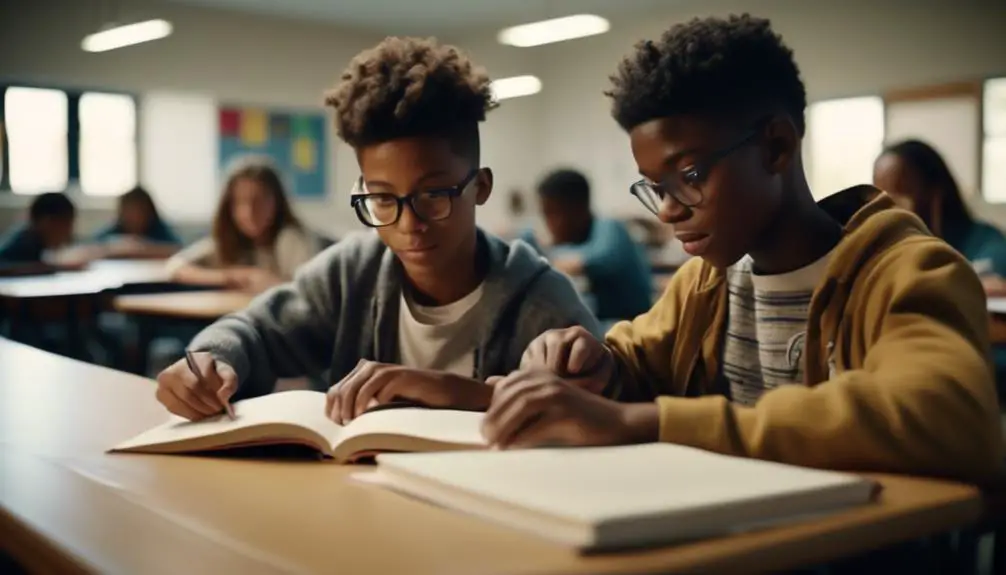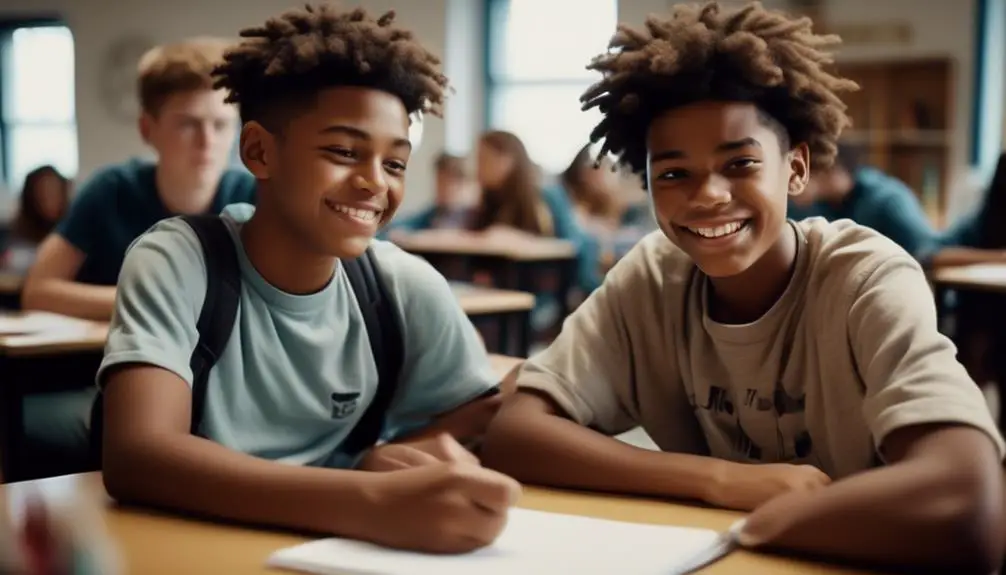In the modern educational landscape, the importance of a classroom buddy system cannot be overstated.
This system provides students with a sense of belonging, encourages cooperation, and helps build strong interpersonal relationships.
Through the buddy system, students can develop communication skills, empathy, and a deeper understanding of diverse perspectives.
It also serves as a valuable tool for promoting inclusivity and addressing individual learning needs, ultimately contributing to a positive and enriching educational experience for all students.
In this post, I have discussed some of the benefits of a buddy system in my classroom.
Why a Buddy System is beneficial for my students?

Implementing a classroom buddy system has numerous benefits for students as shown below:
Supportive Learning Environment
Creating a supportive learning environment through a classroom buddy system promotes collaboration and empowers students to thrive academically and socially. This approach encourages students to actively engage with their peers, share ideas, and work together towards common goals.
Positive reinforcement plays a crucial role in nurturing a supportive environment, as buddies can motivate and uplift each other, reinforcing a sense of accomplishment and self-worth. Mutual support within the buddy system ensures that students feel safe to take risks, ask questions, and seek help when needed, fostering a secure environment for personal and academic growth.
Effective communication between buddies is key to creating a supportive learning environment, as it allows students to express their thoughts, feelings, and concerns openly, leading to better understanding and empathy.
Academic Collaboration and Success
Implementing a classroom buddy system has been crucial in fostering academic collaboration and success among my students.
By encouraging students to work together, the buddy system promotes the formation of study groups and enhances group projects.
When students collaborate as learning partners, they can share knowledge, skills, and perspectives, leading to a deeper understanding of the material.
This cooperative learning approach not only strengthens their academic performance but also cultivates essential teamwork and communication skills.
Through the buddy system, students support each other, celebrate achievements, and navigate challenges together, creating a positive and empowering academic environment.
As a result, they feel more motivated and engaged in their studies, which ultimately leads to increased learning outcomes and overall success.
The buddy system not only enhances academic collaboration but also fosters a sense of community and support within the classroom.
Social and Emotional Development
The classroom buddy system is a great way to foster social and emotional development among students. Not only does it encourage academic collaboration, but it also creates a sense of community and support within the classroom. By participating in the buddy system, students have the opportunity to develop important skills that contribute to their overall well-being and growth. Let’s explore three key ways in which the buddy system supports social and emotional development:
- Emotional Regulation: Through the buddy system, students learn how to identify and manage their emotions in a supportive and nurturing environment. They can express their feelings and receive guidance from their buddies, which helps them develop important emotional regulation skills. This ability to understand and cope with their emotions is crucial for their social interactions and overall mental well-being.
- Social Interaction: Interacting with their peers through the buddy system allows students to develop essential social skills and empathy. They learn how to communicate effectively, listen actively, and collaborate with others. By working together on projects and engaging in conversations, students develop a deeper understanding of different perspectives and learn to appreciate diversity. These social interactions provide them with a solid foundation for building positive relationships throughout their lives.
- Friendship Dynamics: The buddy system also helps students understand the complexities of relationships and fosters healthy and meaningful connections. They learn how to navigate through different friendship dynamics, such as resolving conflicts, supporting each other, and respecting boundaries. These experiences teach them valuable lessons about trust, loyalty, and compromise, which are essential for building and maintaining friendships.
Peer Motivation and Engagement
Since implementing the classroom buddy system, I’ve noticed a significant increase in peer motivation and engagement among my students. They’re working together more collaboratively, which is motivating them to excel.
The support they receive from their peers within the buddy system has greatly enhanced student engagement, creating a more interactive and encouraging environment. Not only are students actively participating in group activities, they’re also empowering each other to take on challenges with confidence.
The positive relationships formed through the buddy system have strengthened student involvement in classroom discussions and activities.
Improved Communication Skills
The classroom buddy system has proven to be beneficial for my students by enhancing their communication skills through interactive peer support and collaboration.
This approach promotes effective listening, constructive feedback, and understanding of nonverbal cues, all of which are essential for developing strong communication skills.
By actively engaging in conversations with their peers, students learn to listen attentively, provide helpful feedback, and interpret nonverbal cues, thus honing their ability to communicate effectively.
Additionally, the buddy system provides a platform for students to practice conflict resolution and express themselves verbally, which are crucial skills for personal and academic growth.
Through this system, students not only improve their communication skills but also learn the importance of empathy and cooperation, which are necessary for effectively serving others.
Enhanced Problem-Solving Abilities
Working collaboratively with a classroom buddy can help students enhance their problem-solving abilities. By actively engaging with their buddy and considering different perspectives, students can gain a deeper understanding of complex challenges.
The classroom buddy system promotes critical thinking by encouraging students to analyze problems from various angles and explore different problem-solving strategies. Through collaborative learning, students have the opportunity to exchange ideas, learn from each other, and develop their creativity in generating solutions.
They can also leverage teamwork dynamics to divide tasks, share responsibilities, and effectively tackle complex problems. This approach not only improves individual problem-solving skills but also teaches students the importance of cooperation and collective intelligence.
It empowers students to approach challenges with confidence, knowing they have the support and diverse insights of their classroom buddy. Ultimately, this prepares them for real-world problem-solving scenarios.
Building Trust and Rapport
The classroom buddy system is a great way to enhance student collaboration and problem-solving skills. It not only fosters trust and rapport among students but also creates a positive and supportive learning environment.
Trust is crucial for student confidence, as it allows them to feel secure in sharing their thoughts and ideas with their peers. By creating connections between students, the buddy system fosters a sense of belonging, making students feel supported within the classroom. This, in turn, promotes a friendly and inclusive atmosphere.
Fostering relationships through the buddy system ensures that students have someone to rely on, creating a network of encouragement and assistance. Ultimately, the classroom buddy system not only enhances academic growth but also nurtures the overall well-being of students.
Encouraging Teamwork and Camaraderie
Building trust and rapport through the classroom buddy system sets the stage for encouraging teamwork and camaraderie among students. It creates an environment where friendship, collaboration, and peer interaction thrive.
By working together, students develop a support system and mutual assistance, creating a learning partnership that enhances their educational experience.
The buddy system is important for community building and connection development, as it allows students to form meaningful relationships with their peers. Through activities and projects, students learn the value of teamwork and the satisfaction of achieving common goals.
The buddy system not only provides academic support but also nurtures a sense of belonging and togetherness. It’s through this collaborative approach that students learn the importance of supporting one another, thus fostering a culture of camaraderie and teamwork.
Fostering Empathy and Understanding
Implementing a buddy system in the classroom has numerous benefits, including fostering empathy and understanding among students. This approach helps students develop essential life skills, such as empathy and understanding. Here’s how it works:
- Building Relationships and Compassion: Buddies learn to appreciate each other’s differences and develop genuine care and concern for one another.
- Creating Peer Support and Connection: The buddy system creates a network of support where students feel valued and understood by their peers, fostering a sense of belonging.
- Encouraging Collaborative Learning and Kindness: By working together, students learn the importance of collaboration and kindness, which contributes to a positive classroom environment.
Implementing a buddy system not only nurtures emotional intelligence but also encourages cooperation among students. This system helps them better understand and support each other, leading to a more inclusive and compassionate classroom environment.
Strengthening Peer Relationships
A buddy system creates a supportive environment where students can rely on each other for friendship and assistance. This fosters a sense of trust and teamwork among students, promoting their emotional development and motivation.
By working together, students learn valuable problem-solving skills, which can enhance their engagement in the learning process. The buddy system also encourages students to form meaningful connections, understand the importance of empathy, and build a supportive community within the classroom.
As a result, it not only enhances their academic experience but also contributes to their personal growth. Strengthening peer relationships through a buddy system is an integral part of creating an environment where students feel valued, supported, and empowered to thrive both academically and socially.
Promoting Inclusivity and Cooperation
Students who participate in the buddy system develop meaningful connections and trust, which in turn promotes inclusivity and cooperation within the classroom community. This creates an environment where every student feels valued and included, enhancing their overall learning experience.
Here’s how the buddy system contributes to promoting inclusivity and cooperation:
- Teamwork Dynamics: Students learn to collaborate, appreciate each other’s strengths, and support one another in achieving common goals.
- Inclusive Interactions: The buddy system encourages students to interact with peers they may not have otherwise engaged with, fostering a sense of belonging for everyone.
- Cooperative Learning: Collaborative activities and discussions facilitated by the buddy system promote a culture of shared learning and understanding.
What is a Classroom Buddy System?

The Classroom Buddy System is a collaborative learning approach that pairs students to support each other academically and socially. It promotes effective communication, student collaboration, and peer support, leading to improved academic progress and social integration.
As an advocate of the buddy system, I believe it is a powerful tool for creating a supportive and inclusive classroom environment. Through effective communication, students learn to express their thoughts, actively listen, and develop empathy towards their peers.
This fosters a culture of understanding and cooperation, which is essential for a harmonious learning atmosphere. The buddy system encourages student collaboration, allowing individuals to share their strengths and knowledge, ultimately benefiting each other’s academic progress.
Additionally, it provides peer support, fostering a sense of belonging and acceptance, which is crucial for social integration. To illustrate the impact of the Classroom Buddy System, consider the following table:
| Benefits of Classroom Buddy System |
|---|
| Encourages effective communication |
| Fosters student collaboration |
| Provides peer support |
| Enhances academic progress |
| Promotes social integration |
Conclusion
Having a classroom buddy system is a wonderful idea. Who wouldn’t want to have a friend to share the ups and downs of the school day with?
It’s important for students to have personal space and independence, but having a buddy can provide companionship and support.
It’s always exciting to find out who your buddy is going to be, like a mini reality show in the classroom.
It’s a fun and valuable experience for students to have a buddy by their side.














